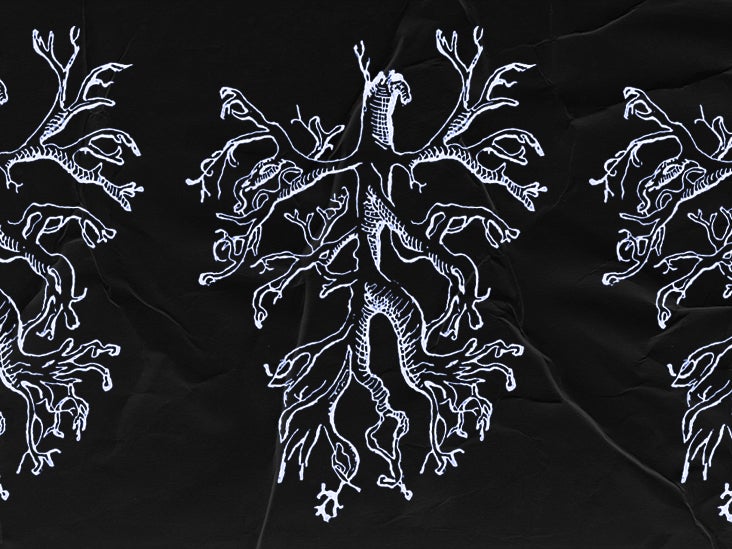Plastic bronchitis: Symptoms, causes, treatments, and more - Medical News Today

Plastic bronchitis is a rare respiratory condition that causes the formation of bronchial casts. The casts consist of thick, fibrinous mucus, which fills the airways.
Plastic bronchitis is an uncommon lung condition that causes rubbery mucus plugs, or casts, to form in the airways of the lungs. In some cases, the casts have the shape of tree branches.
The casts consist of cellular material and mucus. Depending on the severity, casts may block a person's airway and interfere with their breathing. The condition can become life threatening.
Plastic bronchitis occurs
This article discusses plastic bronchitis in more detail, including its symptoms, causes, diagnosis, treatments, and outlook.
The symptoms of plastic bronchitis can vary depending on the size of the cast formations and their location in the airway. For example, the casts may fill the entire airway of the lung. In other cases, casts may cover a small segment of one bronchus, which is an airway
Coughing is one of the main symptoms of plastic bronchitis. Some people cough up the casts, which can become large. For others, it is difficult to cough the material out of the lungs, which may cause a choking sensation.
Other
Doctors
However, doctors have identified some conditions associated with an increased risk of developing plastic bronchitis. For instance, research indicates that causes of plastic bronchitis in children may include infections, inflammatory processes, and certain surgical procedures, including the Fontan procedure, a type of open-heart surgery.
According to a 2019 case study, the rate of plastic bronchitis after the Fontan procedure ranges from 4–14%.
Possible risks for developing plastic bronchitis as an adult include infection, medications, surgical procedures, and abnormal lymphatic fluid flow due to a disease or structural issue.
Fluid travels through the lymphatic system. If this does not work properly, fluid may not drain away from the lungs. This extra fluid may form a solid structure and create casts in the bronchi.
Another possible risk factor may involve when a person requires a breathing tube for a ventilator in their airway for an extended amount of time. A 2016 case study found that using a ventilator for a prolonged period can cause trauma to the trachea and impair the flow of mucus, which may increase the risk of plastic bronchitis.
Other possible risk factors include:
No definitive diagnostic criteria exist for plastic bronchitis. Doctors
During a physical exam, a healthcare professional may listen to a person's breathing to check for wheezing or decreased lung sounds. Doctors may also note coughing and whether a person coughs up any casts.
Imaging studies, such as a CT scan or chest X-ray, may show complications, for instance, a partially collapsed lung.
A bronchoscopy can also help confirm a diagnosis. During the procedure, a doctor views the inside of the lungs through a scope they insert into the airway. The presence of casts may confirm a plastic bronchitis diagnosis.
Treatment for plastic bronchitis
Airway management
Since plastic bronchitis can make breathing difficult, treatment may include airway management. In severe cases, an individual may require a breathing tube and mechanical ventilation to assist with their breathing. For instance, some people may require supplemental oxygen if their blood oxygen levels decrease.
Cast removal
One of the main treatments for plastic bronchitis involves a healthcare professional removing thick casts from the airway.
Doctors most commonly remove these casts by performing a bronchoscopy. In this procedure, a healthcare professional uses a scope inserted through the mouth into the airways. It allows the doctor to see the location of the casts. Special tools on the scope assist with removing the casts.
Medications
A doctor may prescribe different types of medications to a person with plastic bronchitis.
Corticosteroids may help decrease the underlying inflammation that may occur with plastic bronchitis. This may inhibit cast formation and alleviate a person's plastic bronchitis symptoms.
Antibiotics may also help decrease the formation of casts and treat underlying infections that contribute to the condition. Doctors may recommend different types of antibiotics, depending on the organism causing the infection.
Often, doctors obtain a sample of the cast to determine the microbe present and target antibiotic therapy, as needed.
Mucolytics, such as N-acetylcysteine, help thin mucus to make it easier for a person to cough a cast out of the lungs.
Lymphatic surgical techniques
Healthcare professionals may also recommend newer treatment options, including lymphatic embolization, stent grafting, and duct ligation techniques. These treatments aim to control lymphatic flow and prevent casts from forming.
The outlook for people with plastic bronchitis may vary depending on the location and size of the casts. If a cast blocks the main airway completely, it may lead to asphyxiation. Plastic bronchitis's mortality ranges from about
People with the condition may require frequent hospitalizations and various procedures, such as repeated bronchoscopies.
A person should speak with a healthcare professional if they suspect they may have plastic bronchitis. A doctor can provide an accurate diagnosis and appropriate treatment on an individual basis.
Plastic bronchitis involves the formation of thick rubbery casts consisting of mucus. The casts can lead to significant respiratory distress.
The condition is rare, but research indicates it occurs more often in children, especially those that undergo heart surgery.
A doctor may treat the condition by removing the casts and prescribing medications. A person should speak with a healthcare professional if they are experiencing symptoms of plastic bronchitis. A doctor can investigate a person's symptoms and provide appropriate treatment for any underlying conditions.



Comments
Post a Comment